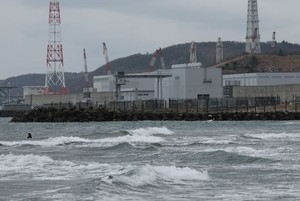THE ASAHI SHIMBUN
May 7, 2021 at 17:22 JST
 A prefabricated testing center for the novel coronavirus in Miyoshi, Saitama Prefecture, on Dec. 28, when new cases were surging (Asahi Shimbun file photo)
A prefabricated testing center for the novel coronavirus in Miyoshi, Saitama Prefecture, on Dec. 28, when new cases were surging (Asahi Shimbun file photo)
Health officials are warning against false assurances from the lower infection numbers reported during the Golden Week holidays, saying signs actually point to a more dire COVID-19 situation in the coming weeks.
“New cases appear to be ebbing now but that is because fewer people got themselves tested for the virus during the Golden Week holidays,” health minister Norihisa Tamura told a meeting of an expert panel advising the ministry on the pandemic on May 6.
The national daily average of new COVID-19 cases for the week between April 22 and April 28 was 4,923. The comparable figure was 4,886 per day between April 29 and May 5, when the holiday period ended.
The daily average number of diagnostic tests conducted nationwide for the virus was 64,457 in April. The figure decreased by about 30 percent to 44,118 from May 1 to May 4.
Tokyo reported 591 new infections on May 6, a relatively low tally for a Thursday.
Sharing Tamura’s view, metropolitan health officials cautioned against taking the figure as a sign of a declining trajectory during the third state of emergency in the capital.
They said the May 6 number largely reflected the fact that fewer tests were conducted because many hospitals were closed during the holidays. They also cited a delay in reports on new cases confirmed from public health centers during Golden Week.
The officials said other numbers indicate that new infections will start rising again.
More Tokyo residents are contacting consultation centers about fevers, a common symptom of COVID-19. And the rate of positive tests has also been increasing.
The health officials said the situation now is similar to what occurred late last year before the third wave of infections hit the capital.
The number of people who contacted consultation centers ranged from 756 to 1,170 a day in late March after the second state of emergency was lifted for Tokyo.
But the daily number topped 2,000 in May.
The daily average number of consultations over the week through May 4 was 2,079, surpassing 2,000 for the first time since the week through Dec. 31.
A week later, on Jan. 7, the number of new COVID-19 cases hit a record 2,520 in Tokyo.
The rate of patients who tested positive for the novel coronavirus was 9.2 percent in the week through May 4, 3 percentage points higher than a week earlier.
The positive test ratio also jumped when the number of new cases surged in Tokyo late last year.
N501Y, a COVID-19 variant that is believed to be 30 to 90 percent more contagious than the initial strain, is fast circulating in Tokyo.
An estimated 67.9 percent of patients in Tokyo who tested positive in the most recent week were infected with the variant.
The ratio was 59.6 percent in the preceding week and 32.8 percent in the week before it.
“We need to thoroughly implement anti-coronavirus measures to stem the spread of the highly infectious variants,” Tokyo Governor Yuriko Koike said at a meeting of health experts on May 6.
Central government officials said they were worried that the variants are spreading in local regions, not just in urban centers, such as Tokyo and Osaka.
Between April 28 and May 4, the number of new cases per 100,000 people was 28.44 in Hokkaido, 25.49 in Gunma Prefecture, and 33.17 in Okayama Prefecture.
The numbers, each 10 cases higher than in the previous week, put those prefectures in the most serious of the nation’s four-stage levels--25 per 100,000 people--in this category.
(This article was compiled from reports by Jun Tabuse, Hiroshi Ishizuka and Yoshitaka Unezawa.)




















A peek through the music industry’s curtain at the producers who harnessed social media to help their idols go global.
A series based on diplomatic documents declassified by Japan’s Foreign Ministry
Here is a collection of first-hand accounts by “hibakusha” atomic bomb survivors.
Cooking experts, chefs and others involved in the field of food introduce their special recipes intertwined with their paths in life.
A series about Japanese-Americans and their memories of World War II